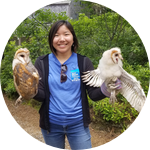About This Project
This project is aimed at understanding the morphological differences between two species of Sphingidae (Hawkmoths). Both species of Apple Sphinx, Sphinx gordius and Sphinx poecila, are found in the Northeastern USA. Due to similarities in appearance, they are hard to separate in the field. This project aims to develop field marks for both adults and larvae, and use those marks to assess the populations found within Massachusetts and evaluate their conservation need.
Ask the Scientists
Join The DiscussionWhat is the context of this research?
This is a pair of species that has always puzzled me! I see what I believe to be both species in very unique pine barrens habitat in Southeastern Massachusetts, but truthfully, without doing genetic barcoding, I can't be totally sure they're both there. This project aims to expand on current knowledge about these species, and setup specific ID features to be able to distinguish both the adults and larvae in the field. A paper that came out not too long ago, showed that many species of Sphingidae were declining across the northeastern USA (Young et al., 2017). Even in this paper, they couldn't separate out these species making it unclear which, if either are declining. I believe one is, and doing this study will make it clear which and allow for research into why.
What is the significance of this project?
These are pollinating moths that contribute to our ecosystem (Haber & Frankie, 1989) (SphingidaeUSA). It would be immensely helpful to distinguish these species more easily, and allow citizen science efforts to really help us capture data on their distribution and abundance. Once we can easily and accurately determine adults and/or larvae, we can develop complete range maps, and examine collections and other records to determine if either species is declining. Additionally, this project will also help determine what future conservation efforts are needed, and how to focus them.
What are the goals of the project?
There are a few goals, the first and foremost: develop visual identification guides that are concrete for both adults and larvae. Currently, the only way to separate these species is by DNA barcode, so barcoding must take place before proper visual identification could possibly be made. Once specimens from the Northeast and other regions have been barcoded and IDed genetically, I will analyze differences between the species. Once these features are determined, a backwards test will be made. I will make species level determinations in the field using these markings, and then barcode them to see if I'm correct. After the marks have been validated, I will establish accurate range maps, and evaluate conservation need in Massachusetts.
Budget
The most expensive part of this study is the DNA extraction and barcoding. This is the cost to do DNA extraction in-house (including cost of materials), and have barcoding done at the Canadian Center for DNA Barcoding (this covers approximately 1000 samples!). Barcoding cannot be completed in house. The travel budget is for the 2021 field work season, this allows the researchers to travel across New England to different sites to collect adults and larvae of these species.
**STRETCH GOAL**
The purchase of two new LepiLED light setups ($450 each plus shipping) would be an incredible help for field surveying. These new, lightweight lights can run off a battery pack rather than a generator. This new light would allow me to survey in areas that are ecologically sensitive, without the fear of pollution, and in addition, they'd allow me to survey areas that I cannot bring a generator into, due to the terrain.
Endorsed by
 Project Timeline
Project Timeline
This research began officially in 2019, when I began making collections for this project. The next step, is to barcode the specimens I have and will collect in the 2021 season. Barcoding should be completed by December 2021. Completion of the ID guides will occur before the 2022 field season, and that season field testing of the ID guides will begin. Publication is expected in 2023 or 2024.
Jan 12, 2021
Project Launched
Dec 31, 2021
Barcoding Completion
May 15, 2022
Completion of Identification Guides
Aug 31, 2022
Field Testing Completion
Oct 30, 2022
Creation of Range Maps
Meet the Team
Affiliates
Teá Montagna
I'm a fifth year PhD candidate researching the ecology and life history of Sphingidae (Hawk Moths)! One of my current projects involves rearing Sphingidae larvae and trying to figure out what causes their color variation. Additionally, I'm working on conservation assessments for two species, and I'm examining adult and larval survival along an urban to rural gradient. If you have questions, please feel free to ask! Take a look at my website, SphingidaeUSA, that outlines the life histories of most of the Sphingidae found in the US, it is currently a work in progress, and updates are made monthly.
Project Backers
- 83Backers
- 160%Funded
- $5,613Total Donations
- $67.63Average Donation


